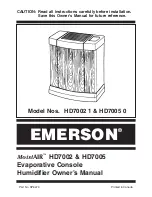
3
EGW05-SWHPEG-20140724
TM
TM
Table 1-2. Recommended Pool Water Chemistry
Pool
Spa
Ideal
Min
Max
Ideal
Min
Max
Total Chlorine (ppm)
1.0 - 3.0
1
3
3.0 - 5.0
1
10
Free Chlorine (ppm)
1.0 - 3.0
1
3
3.0 - 5.0
1
10
Combined Chlorine (ppm)
0
0
0.3
0
0
0.3
Bromine (ppm) if applicable
2.0 - 4.0
2
4
3.0 - 5.0
2
10
pH
7.4 - 7.6
7.2
7.8
7.4 - 7.6
7.2
7.8
Total Alkalinity (ppm)
80 - 100
80
180
80 - 100
60
180
TDS (ppm)
1000 - 2000
300
3000
1000 - 2000
300
3000
Calcium Hardness (ppm)
200 - 400
150
1000
200 - 400
150
1000
Calcium Acid (ppm)
30 - 50
10
100
30 - 50
10
100
EQUIPMENT CHOICES
OVERVIEW
There are several methods for controlling humidity, temperature and ventilation in poolrooms. Each method offers some
level of control, but there can be significant differences in first cost and operating cost of each method. Geographic
location, degree of comfort, unit cost and operational cost must be evaluated in the selection of the correct system.
Ventilation with Heating
•
Moisture removal is accomplished through the dilution with dryer outside air
• High cost of operation (air reheating)
•
Lowest first cost
• No opportunity to recover energy in the ventilation airstream
• No opportunity to recover energy into the pool water
•
No integral cooling capability
•
Summer space conditions can be unbearably hot and humid
Ventilation with Heating and Energy Recovery
•
Moisture removal is accomplished through the dilution with dryer outside air
•
Significant heat recovery from ventilation air stream
•
Cost-effective method but with modest operating cost
• Performance limitations in humid areas or during summer peaks
• No opportunity to recover energy into the pool water
•
No integral cooling capability
Mechanical Dehumidification
•
Moisture removal is accomplished through mechanical refrigeration
•
Significant heat recovery using “heat pump” technology
•
Recovers the most energy from the ventilation airstream
•
Offers an opportunity to recover energy into the supply airstream
•
Offers an opportunity to recover energy into the pool water
•
Higher first cost with lower operating cost
•
No performance limitations based on location
• Tightest control of setpoint conditions
•
Integral cooling capability
•
Can be integrated to include appropriate ventilation strategies










































